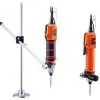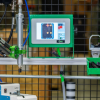As lean manufacturing increases in popularity, manufacturers may begin assessing their assembly practices and evaluate ways to improve efficiency and lower costs. Lean manufacturing aims to deliver high-quality products while minimizing waste and maximizing profits. At the core of lean manufacturing is the relentless pursuit of efficiency and waste reduction, key factors for any organization’s success (Principles, n.d.). Lean manufacturing can be achieved with the help of automatic tape machines.
The Role of Tape Dispensers in Lean Manufacturing
Tape dispensers can help manufacturers fully embrace lean principles. By automating certain procedures, tape dispensers contribute to increased productivity, improved accuracy, reduced waste, and minimized physical strain on workers.
Increased Productivity
One of the primary benefits of using tape dispensers is increased productivity. These devices make the assembly process easier for workers by dispensing and cutting the correct amount of tape with precision. Through the press of a button or the use of sensors, tape dispensers ensure that workers can focus on other aspects of the assembly line while having tape readily available when needed.
Improved Accuracy
Also, the importance of consistency cannot be overstated, and tape dispensers deliver consistent results by cutting the same amount of tape each time. This level of accuracy is especially beneficial for applications requiring multiple pieces of tape as fasteners or seals, where uniformity leads to higher quality finished products.
Reduced Waste
Waste reduction is another way to lower costs and operate a lean facility. Certain tape, such as Kapton tape, can be expensive, making any waste costly. Tape dispensers cut tapes at precise measurements, minimizing waste caused by cutting too long or too short of pieces for specific applications. This efficiency not only reduces costs but also promotes sustainability by limiting material waste.
Reduced Strain and Injury Risk
Manual tape cutting can be physically demanding, leading to strain on workers’ hands and wrists, and increasing the risk of repetitive motion injuries. Tape dispensers alleviate this strain by automating the cutting process and reducing the physical strain on workers. By minimizing injury risks, tape dispensers contribute to a safer work environment while improving overall productivity.
To conclude, embrace lean manufacturing with automatic tape machines like the EZ-9000GR. By enhancing productivity, accuracy, waste reduction, and worker safety, tape dispensers align with the core objectives of lean manufacturing, making them a valuable asset for any manufacturing operation requiring the use of tapes as fasteners.
References:
- Principles of Lean Manufacturing | ASCM. (n.d.). ascm.org







